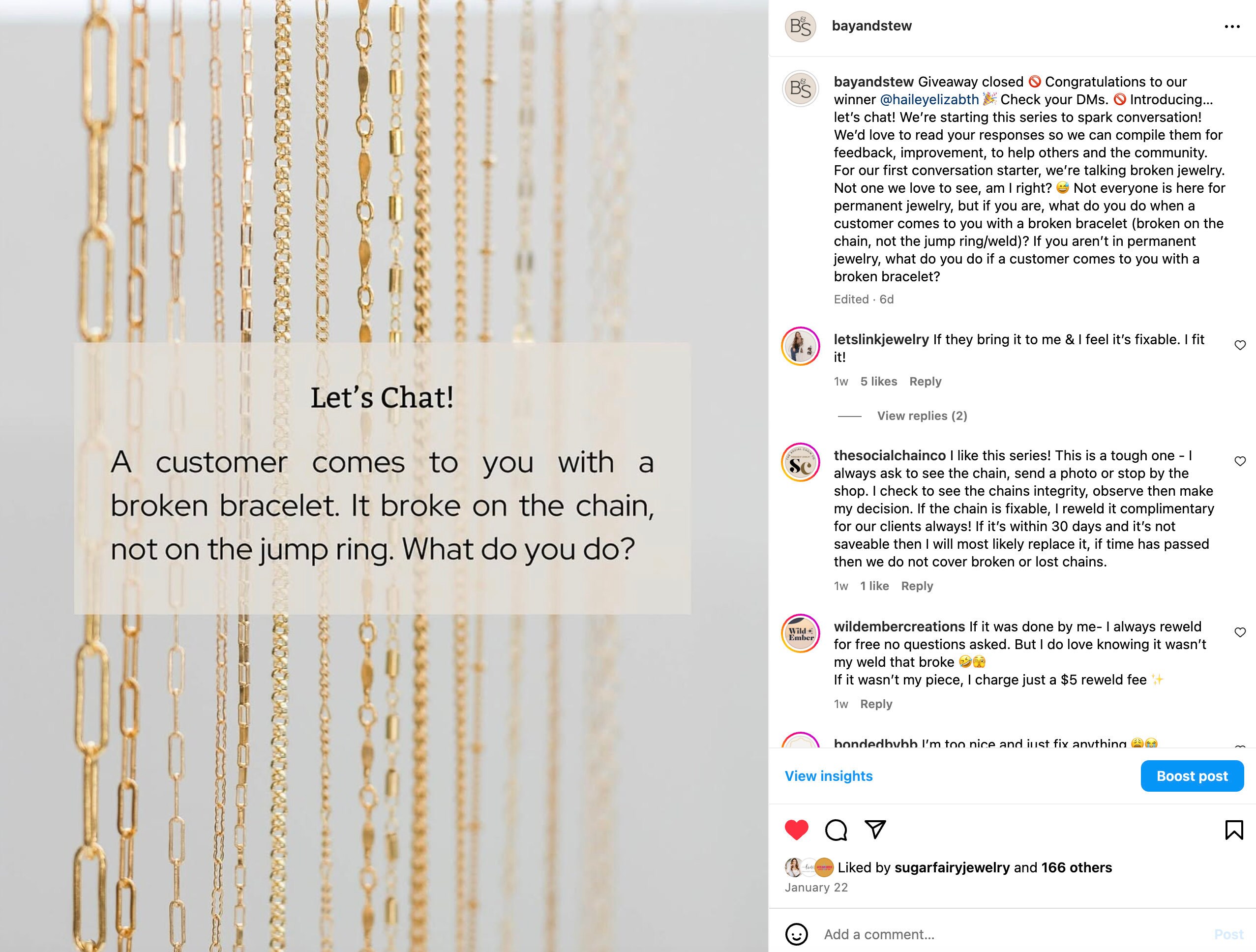A customer asks you to fix their broken chain… What do you do? We posted this question for our community on Instagram @bayandstew and collected lots of insight from permanent jewelry artists! In this Chain Chat blog, you’ll learn about chain repair strategies, common policies, and how to prevent permanent jewelry from breaking in the first place (win, win!)

REPAIR: how to salvage an existing chain
Why (and where!) did the chain break? That will determine your best price and repair plan. Most customers remember how their permanent jewelry broke, but not always – the chain can provide information, too. Start by taking a close look – either in person or with a detailed photo.
“I always ask for a photo. If it clearly snagged on something and broke, I will offer a discount to replace it.” @linked.by.soph
You should be able to find out:
What component failed?
- Jump ring
- Connector
- Chain link
- Weld site
“If it’s a broken weld, I apologize like the world is ending (because I’m dramatic) and fix it for free.” @mindi0915
And what was the cause?
- Flattened links
- Tugged and stretched
- Corroded materials
- Brute force break
“Depending on the chain, I either clip a link and weld it closed or add a jump ring.” @hrltxrn
If the chain is stretched, you might be able to cut off excess by the old jump ring and create a clean line to re-weld. It’s usually easiest to connect broken ends with a new jump ring, but only if the links aren’t flattened. Again, that initial inspection will help you decide what’s possible.
“Some chains you can easily fix with a jump ring, and you’d never know since the bracelet is a similar shape (that’s the best-case scenario!)” @ember_and_co_jewelry
If you notice a particular chain style or brand that’s frequently breaking, that might suggest a more delicate chain that you may not find suitable for your permanent jewelry customers. We recommend keeping a list of repairs, so you can look for patterns and make changes to prevent breakage (see the section about prevention, down below!)
“If I need more length, I’ll ask if they want to add a connector to get it to that perfect length after a break.” @bpiester_duval
Speaking of length, you can (and should!) fix sizing issues during the jewelry chain repair. Most permanent jewelry artists offer to add charms, connectors, or new jump rings to make up for lost or damaged length, but you might actually need to remove links. If you think the permanent jewelry chain was too long in the first place, this is the perfect time to correct it.
“I try to fit them well so they’re not too loose and explain to customers that loose chains are more likely to catch and break. (I learned that the hard way early on!)” @rawamor
POLICIES: when and why to charge for repair
In all the replies to our post, two words came up again, and again, and again… customer service. The most successful permanent jewelry brands have clear, consistent repair policies, and it’s all about how you communicate them to customers.
“If you are willing to work with the customer and help them out, I believe it creates a customer for life! Customer service is huge!” @2infinit_y
If the chain was originally purchased somewhere else, re-weld fees are standard – ranging from $5 to $25. Based on our comments, it sounds like $5 is the most common price for re-weld repairs, and it often gets waived entirely.
“Most of the time while they’re at my studio wanting a repair, they end up purchasing a new piece and I won’t charge them a re-weld fee.” @bare.jewelry_
But what if the permanent jewelry came from your shop, and the repair is for YOUR customer? How long will their chain be covered, and should the repair be free? Comments about this chain repair policy varied the most widely. Some permanent jewelry businesses offer short warranties, lasting just 15 or 30 days, while others advertise free-fix policies for up to a year.
“I have a free-fix policy because I know I’d be so disappointed if mine broke!” @bound.hawaii
PREVENTION: permanent jewelry supplies and styles
Delicate, dainty chains are usually the most likely to break, even if the quality is good. So how do you work around that? Advice says to communicate or eliminate.
Most permanent jewelry makers recommend ranking chains by durability and chatting with shoppers about their lifestyle and daily activities before zapping. For example, if someone has small kids and loves to swim, you might steer them away from delicate styles. Instead, educate them about how chlorine exposure can weaken chains over time, and thicker links will be less likely to stretch as much.
“I’m always open and honest about my chains. If they are dainty, I tell customers that there’s more of a chance they will break or stretch.” @weldandwander
But even if customers are gentle with their jewelry and the permanent bracelet is fitted properly, ultra-delicate chains can still snap. Some permanent jewelry artists go so far as to stress-test chains before ordering, or track the chain styles that need frequent repairs.
“I buy samples of chain and try to snap them myself. Many do… many don’t! I only buy more of what doesn’t snap.” @angelawozniakjewellery
“Over the years, I have stopped carrying certain chains that I saw come back frequently.” @Ashley.truelove
The material quality matters, too! Gold filled jewelry has a 5% layer of gold on the surface, compared to the weight of its core, and it’s permanently bonded through heat and pressure. That’s a must-have for everyday wear and permanent durability!
Ready to restock gold-filled chains, jump rings, connectors, and charms? Browse and shop at Bay & Stew.

